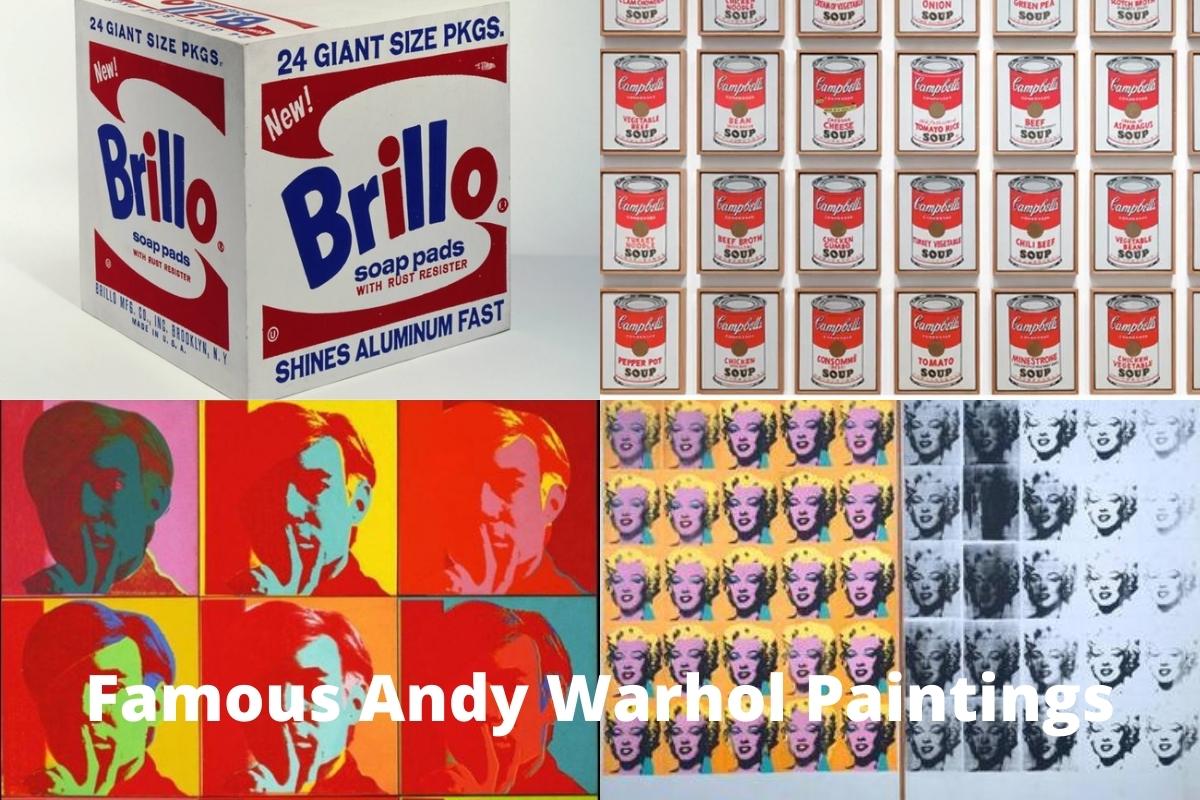Andy Warhol (August 6, 1928 – February 22, 1987) was an American artist, filmmaker, and producer. He was a pioneer of the pop art movement.
His works cover a number of mediums, including painting, silk-screening, photography, video, and sculpture, and examine the link between creative expression, advertising, and celebrity culture that blossomed in the 1960s.
Warhol began his career as a successful commercial illustrator. He gained fame as an important and contentious artist in the late 1950s after displaying his work in many galleries.
By the early 1960s, pop art had developed into an experimental style that a number of artists adopted independently; some of these pioneers, such as Roy Lichtenstein, would eventually become associated with the genre.
Warhol, who would become known as the “Pope of Pop,” embraced this new approach, which allowed for the inclusion of common topics in the artist’s palette.
Warhol painted his iconic Campbell’s soup cans for his first big show, which he said he ate for lunch for the majority of his life.
He built his subsequent style and topics from these beginnings. Rather than focusing on a distinctive theme, as he first intended, he increasingly focused on a signature style, thereby excluding the handcrafted from the creative process.
Warhol regularly included silk-screening into his work; his later works were based on slide projections. At the height of his renown as a painter, Warhol employed numerous helpers to create his silk-screen multiples, according to his instructions to create unique variants and variations.
Famous Andy Warhol Paintings
1. Campbell’s Soup Cans
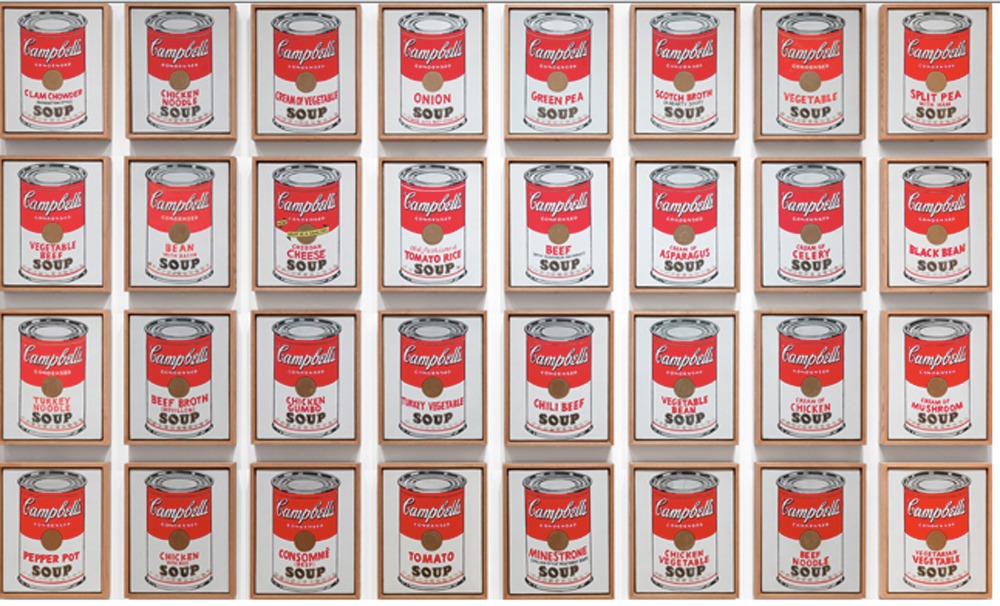
Campbell’s Soup Cans was created between November 1961 and March or April 1962. It is made up of thirty-two canvases, each measuring 20 inches (51 cm) in height and 16 inches (41 cm) in breadth and each containing a painting of a Campbell’s Soup can—one of each of the canned soup types produced by the business at the time.
The non-painterly paintings were created by a screen printing method and represent iconography from popular culture; they are part of the pop art trend.
Before he began painting, Warhol worked as a commercial illustrator. On July 9, 1962, Warhol’s first one-man gallery exhibition, Campbell’s Soup Cans, opened at the Ferus Gallery in Los Angeles, California, organized by Irving Blum. Pop art made its West Coast premiere at this show.
The subject matter aroused controversy at first, in part because it was an insult to the technique and philosophy of the preceding art movement of abstract expressionism.
Warhol’s motivations as an artist were called into doubt. Because of his affiliation with the topic, Warhol’s name became associated with the Campbell’s Soup Can paintings.
2. Marilyn Diptych
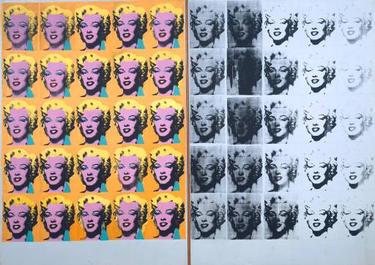
The Marilyn Diptych (1962) is a silkscreen artwork, and it is one of the artist’s most well-known depictions of the movie actress.
The artwork is made up of 50 images. Each of the actress’s images is based on a particular promotional shot from the film Niagara (1953).
The underlying advertising shot, which Warhol used as the foundation for many of his paintings and prints of Marilyn, as well as the Marilyn Diptych, was owned and distributed by her film company. Marilyn Diptych was finished only a few weeks after Marilyn Monroe died in August 1962.
This artwork was created using the silk-screening process. The twenty-five photographs on the left are colored, while the twenty-five images on the right are black and white. The Marilyn Diptych is in the Tate’s collection.
3. Shot Marilyns
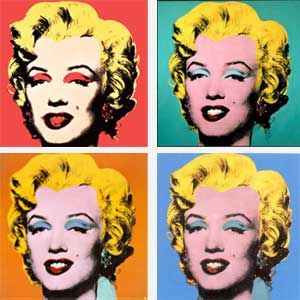
The Shot Marilyns were created in 1964 and comprise of four canvases, each 40-inch square and each with a painting of Marilyn Monroe shot in the forehead by a single bullet.
In 1964, Warhol created five distinct colored Marilyns with various colored backgrounds: red, orange, light blue, sage blue, and turquoise. He kept them in The Factory, his Manhattan studio on East 47th Street.
Dorothy Podber, a friend of Factory photographer Billy Name, saw the freshly finished paintings piled against one other at the studio and asked Warhol if she could shoot them.
Warhol consented, believing she meant she wanted to photograph the works. Podber donned her black gloves, took a little handgun from her handbag, and fired a shot into the stack of four “Marilyn” paintings, which are now known as The Shot Marilyns. The fifth artwork, with a turquoise backdrop, was not among those on the stack.
4. Brillo Box
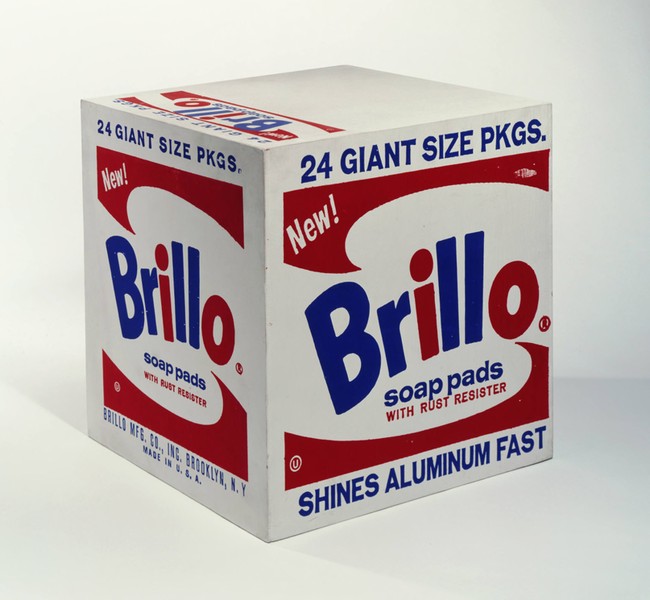
Sculptures that replicate the packaging of mass-produced commodities—cornflakes, Kellogg’s Del Monte peaches, Brillo scouring pads—are among Warhol’s most well-known works.
The sculptures were made in the same way as everyday things are made: effectively and methodically, one after the other, with the help of many different hands. It was no coincidence that Warhol’s workshop was called “The Factory”.
Andy Warhol’s Brillo Boxes are exact replicas of commercial packaging created on wood with synthetic polymer paint and silkscreen print. While they satisfy the premise that art should mimic life, they also raise problems about how we define and evaluate art.
5. Coca-Cola (3)
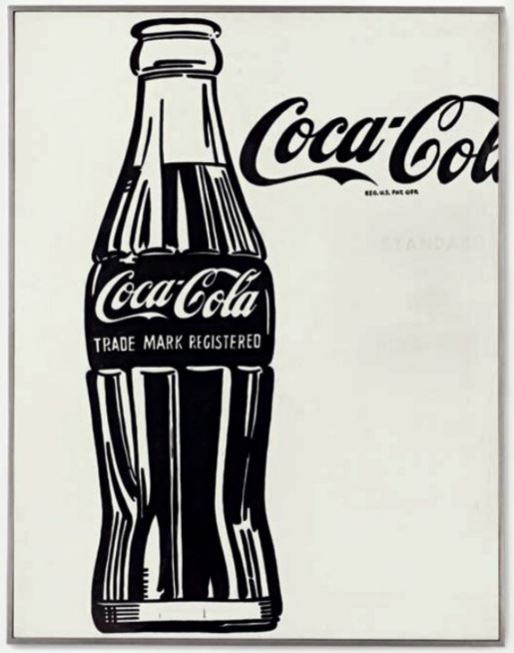
Andy Warhol finished Coca-Cola 3 in 1962 as part of a larger series of Coca-Cola paintings that includes Green Coca-Cola Bottles and Coca-Cola.
The painting, along with others in the series, is regarded as a foundational work of the pop art movement. The work is a 6-foot-tall black-and-white painting of a vintage Coca-Cola bottle.
Warhol originally experimented with Coca-Cola bottles in the early 1950s, when he collaged photos of Coke bottles from periodicals.
Warhol had a distinct viewpoint and interest in Coca-Cola bottles. “A Coke is a Coke, and no amount of money can bring you a better Coke,” Warhol would say, referring to the concept of economic and political equality.
6. Campbell’s Soup I
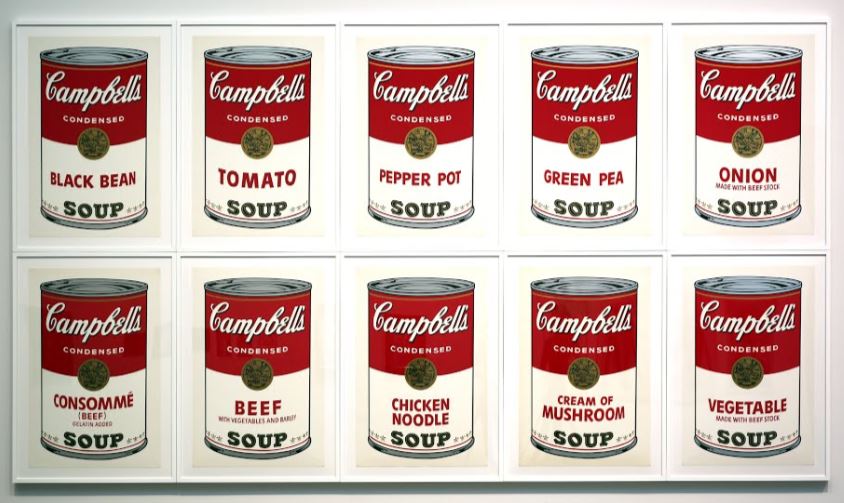
Campbell’s Soup I comprises of 10 prints of Campbell’s Soup cans from 1968.
It is one of the artist’s most well-known and contentious series, and it helped him pioneer the Pop Art movement.
Also Read: Pop Art Artists
It is Warhol’s second series of Campbell’s Soup Can prints, which debuted six years after his initial 32 Campbell’s Soup Cans paintings (above), and was followed by the Campbell’s Soup Cans II portfolio in 1969.
Each portfolio comprises ten screen prints that correlate to the paintings and was one of the first portfolios issued by Factory Additions, a firm Warhol founded to market his prints.
The automated photo silk-screen method would remove all traces of the artist’s touch and provide a degree of perfection that matched the design of the cans. This is an intriguing modification of a media that was previously used to create commercials.
7. Self-Portrait
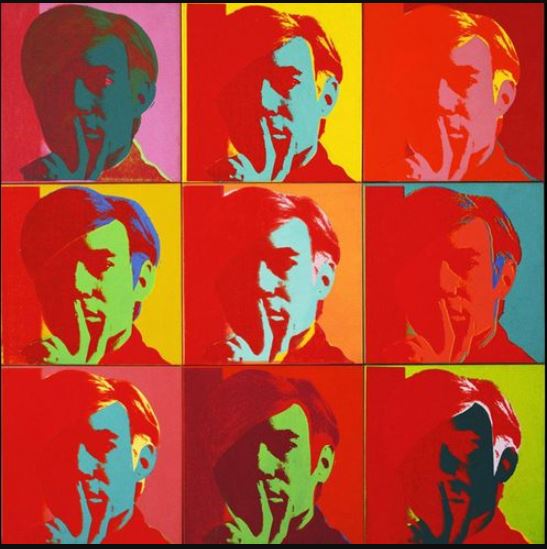
Self-Portrait (1966) was created in a grid of colorful, repetitive silk-screened portraits, which would become one of Warhol’s defining styles. Warhol, an accomplished colorist, combined primary and secondary colors as well as many shades of the same hue.
In the later stages of his career, Warhol shifted his concentration more toward portraiture. He painted portraits of those he admired—musicians Michael Jackson and Grace Jones, boxer Muhammad Ali—as well as affluent socialites he encountered on the New York social scene.
By the mid-1960s, Warhol had gathered a sizable public following of artists, filmmakers, performers, authors, and art customers who were enchanted by his character. Engaging in self-portraiture only served to increase his notoriety.
Warhol’s self-images eventually become as renowned as Marilyn Monroe’s or Elizabeth Taylor’s iconic portraits. The artist had established himself as a star.
8. Dollar Sign
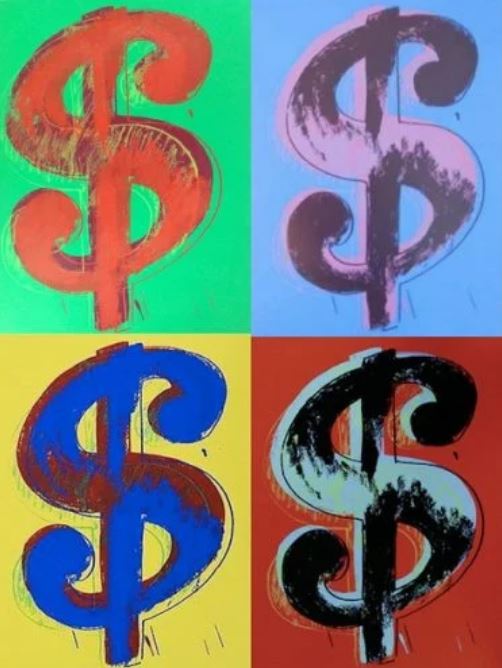
Andy Warhol’s vividly colored 1981 “Dollar Sign” series, comprised of one or more stylized dollar signs, embodies the artist’s views on the link between art and capitalism.
Warhol’s “Dollar Signs,” created using numerous silkscreens for a strong and textured effect, seem to have been stolen from a sketchpad or written over a receipt.
The series links art with money by separating it from cash and expanding it to cartoonish dimensions.
9. Diamond Dust Joseph Beuys
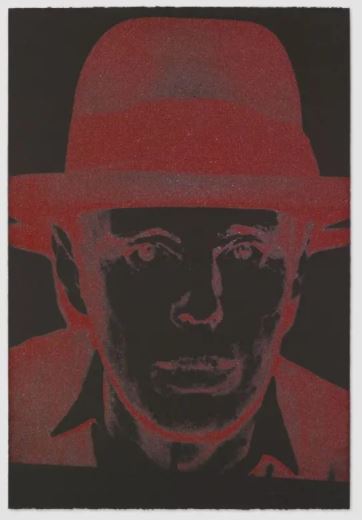
Joseph Beuys (Diamond Dust) is an acrylic and silkscreen ink on canvas work that was produced in 1980.
Joseph Heinrich Beuys was a German artist, teacher, performance artist, and art theorist whose work expressed humanist, sociological, and anthroposophical ideas. He is one of the founders of the controversial art movement known as Fluxus.
Beuys, together with Andy Warhol and Kaii Higashiyama, participated in the “Global-Art-Fusion” initiative on January 12, 1985.
This was a Fax art project started by conceptual artist Ueli Fuchser, in which faxes featuring drawings by all three artists were sent across the globe in 32 minutes — from Düsseldorf (Germany) to New York (USA) to Tokyo (Japan), and received at Vienna’s Palais-Liechtenstein Museum of Modern Art. During the 1980s Cold War, this fax was a message of hope for peace.
10. Red Lenin (FS II.403)
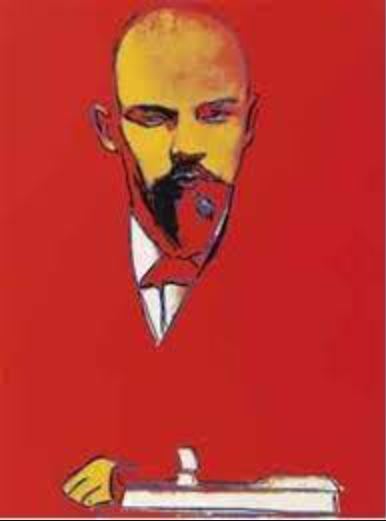
Red Lenin is a screen-print of Vladimir Lenin, one of Russia’s most prominent political leaders and the leader of the country’s communist revolution.
Lenin’s as a subject matter is startling since it differs from the more well-known celebrities and socialites that Warhol was known to paint. Warhol not only broadens his subject matter, but also demonstrates progression within his own pop art style.
The bulk of this screen-print is one bright crimson red, while the features of Lenin’s face and hand are yellow, and his collar and armrest are grey. The work’s simplicity attracts the viewer’s attention to Lenin’s face.

